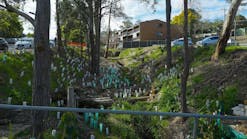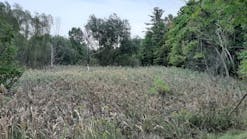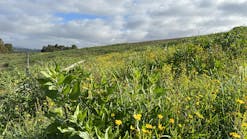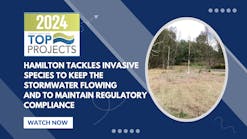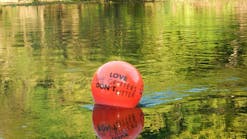Wisconsin Conservation Agency Battle Erosion Online
July 1, 2003
The Soil Conservation Service was born from a nightmare that whirled out of the Plains states in the 1930s. Years of drought and poor agricultural practices had stripped the earth of natural ground cover that held the soil in place. When powerful wind systems swept across the parched land, they churned up clouds of dust, darkening the sky and forcing the migration of hundreds of thousands of people, as described by John Steinbeck in the novel The Grapes of Wrath.
In the wake of the Dust Bowl, the United States Department of Agriculture (USDA) began to see soil erosion as a national menace. The Interior Department handles public lands, but because about 70% of land in the US is held by private landowners – chiefly farmers and ranchers – USDA created an agency dedicated to controlling erosion by promoting responsible stewardship of private land. That agency’s name has since changed to the Natural Resources Conservation Service (NRCS), and it has become USDA’s lead conservation agency. In addition to monitoring soil quality and working with landowners to ensure environmentally sensitive farming and grazing practices, NRCS restores wetlands to foster animal and plant life, reinforces streambanks, and designs terraces to control flooding. The agency works to prevent runoff of sediments and animal wastes, and it builds dams to control the growth of gullies that have cut into the slope of a hill over the years. Strong Local PresenceNRCS was conceived as a vast network of local offices that could be active on the most “micro” levels, engaged with individual landowners and properties. As such, it maintains offices in 3,000 conservation districts, virtually one for every county in the nation. Along with NRCS, these USDA Service Centers usually include staff from other USDA operations, such as the Farm Service Agency, as well as the local county government’s own conservation division. They have had more than enough work to do: Since 1993, these centers have experienced an average 78% increase in workload while their staffs have been reduced by 22%, according to USDA. To boost the productivity and efficiency of NRCS staff, a few years ago USDA instituted the Service Center Modernization Initiative, which focused on bringing labor-saving technologies to the field offices. These include new computer servers, digital cameras, global positioning system (GPS) devices for surveying, and geographic information system (GIS) software for the mapping and design tasks the field staff routinely handles. Computer-aided design (CAD) products that draw upon GIS and GPS mapping advances are one of the tools that have allowed NRCS engineers to make complex measurements more easily and generate designs for dams and wetland restorations much faster than when their work was done on paper.The NRCS operation in Wisconsin offers a model snapshot of the agency’s use of engineering software. Wisconsin has a higher percentage of privately owned farmland than most other states, a robust network of local conservation offices, and some unusual geographical challenges that make erosion control a high priority.Step One Is TopographyWisconsin’s NRCS headquarters in Madison is divided among technical areas, such as geology, forestry, wildlife, and grazing, and the agency’s engineering division is overseen by John Ramsden. In 1998, Ramsden began implementing electronic tools. “Whether we’re doing flood prevention, sediment retention, or building a terrace, the common task they share is that we need to have topographical maps of the area we’re going to design in,” Ramsden says. “So our technicians go to the project site and they take measurements – it could be hundreds of points. These are downloaded into Land Desktop, and at that point we can very quickly turn out a map showing surface topography.” Land Desktop, from Autodesk, works with the basic drawing platform AutoCAD. “This map becomes the base on which we layer design features, and the software gives us the freedom to adjust volumes or dimensions. We can look at several possible versions, which took much longer with paper drafting,” Ramsden notes. “We can very easily make a dam or an embankment higher or steeper. We can see what an excavation would do to roads or make sure we’re not infringing on a wetland. If the curves on a stream are too sharp and we need to reinforce the banks, we can refer to the topography to get the best stream alignment.”Many of the Wisconsin NRCS field offices are co-located with the local counties’ Land Conservation Department offices, and because the majority of these were already using an Autodesk design standard, Ramsden says this was another reason for the NRCS to use the same platform. “We work closely together with our local counterparts – we use the same federal manual for design specifications,” he says. “We need to be able to pass files back and forth; it has to be seamless.”Pinpointing Site Locations Mike Dreischmeier, an engineer in the NRCS Dodgeville office who’s one of the agency’s more knowledgeable AutoCAD users, learned the software in 1995 as a county student intern. He remembers what field engineering work was like before CAD: “You had to record horizontal and vertical angles, stadia and rod readings, and then back in the office you’d have to hand-plot them all on a drafting table. Now you can just use a total station [for surveying] and plug it into a computer. Land Desktop shows you a plot of your survey, with coordinates and elevations. We can create 3D digital terrain models to show surface contours. When we move to design, we can plot cross-section and profile views of storage pits, berms, or drainage ditches we need to excavate.”Dreischmeier notes one feature that has proved handy is the ability to move in reverse: taking specific points from the map of an emerging design and locating them out in the real world. “You can upload points from your drawing back into your data collector, go out to the job site, and figure out exactly where the endpoints will be of the dam you designed,” he explains. “It allows you to locate points that aren’t tied to objects – for example, if you’re building an embankment but you can’t pull a tape measure out to the end of it from the corner of a building. So you put the instrument at the proper angle, and then it directs you out to the right spot, accurate to a tenth of a foot. I used to say you could put a quarter on the ground and find it in the same place a few weeks later.”Pilot Dam Rehab Project
The Eau Claire area office of NRCS is in the northwestern quarter of Wisconsin, in a region that was named the “Driftless Area” because it was missed by glaciers. Whereas glaciated terrain is much flatter and speckled with lakes, the topography of the Driftless Area is steep and hilly, a high-relief landscape of grand bluffs, crags, and ridges perched over narrow, twisting valleys. Those factors mean more erosion as stormwater flows faster down the hills, carrying sediments with it and carving trenches into the land – and more challenges for NRCS. CAD tools have become essential for Laurel Qualley, a civil engineering technician in the Eau Claire office who works primarily on larger “pilot dams” that were built 25-30 years ago under a federally funded project called PL 566. Those dams, which were built to block gully erosion by channeling stormwater through pipes dug under earthen berms, are now beginning to fail; their pipe seams are separating and allowing sediment to seep in. US Senator Herb Kohl won federal funds for NRCS to rehabilitate the dams, and the first part of each job entails creating all-new AutoCAD drawings to replace a pilot dam’s original Mylar plans. “We resurvey everything – the surface contours, the dam’s pool area – and we calculate how much grading we have to do, how much water will be going through the pipe,” describes Qualley. “Then I’ll go into Autodesk Civil Design and draw the steel schedules, the grading areas, and the concrete details. Every part of the design process has been streamlined tenfold. I can change scales quickly, move a dam upstream or downstream, recalculate everything.” Qualley says the Wisconsin NRCS maintains a popular Web site where engineers can download AutoCAD templates for “standard elements” of projects that are frequently used, such as concrete walls, vegetative covers, pipe supports, and the trash racks that cover pipe inlets. “The site has more than 150 different drawings, and I use it for everything. Before we would use three-ring binders and copy drawings from file cabinets. Now the final drawing packages look much more professional.”Restoring WetlandsBeth Kleisath, an engineer in the Eau Claire office, works on the agency’s Wetland Reserve Program in which landowners receive a payment for granting an easement on their land that allows NRCS to convert large plots back into wetlands. If a farmer has dug ditches and installed tiles to drain water from cropland, field staff will break up the tiles and plug the ditches so that the field returns to its native wetland state again. NRCS will excavate “scrapes” that will become small ponds and attract waterfowl. The scrapes need to be built with varying depths, with deeper scrapes holding water longer in a dry spell. “We try to give the terrain a microtopography so it’s not all one level,” says Kleisath. “Some plants and animals like 6 inches of water, others like 2 feet.”If Kleisath is designing an earthen embankment in a wetland or a gully, she uses a Land Desktop feature called Grading Wizard to figure out volumes. “On the terrain map, I’ll draw the length and height of the embankment, and it will show the total volume of fill that is necessary for construction,” she explains. “If we’re excavating a manure pit, the software calculates how much earth we’ll have to remove.”“It’s important because we can give these numbers to contractors and receive accurate cost estimates for the projects,” Kleisath notes. “It’s been a huge time-saver for us.”
